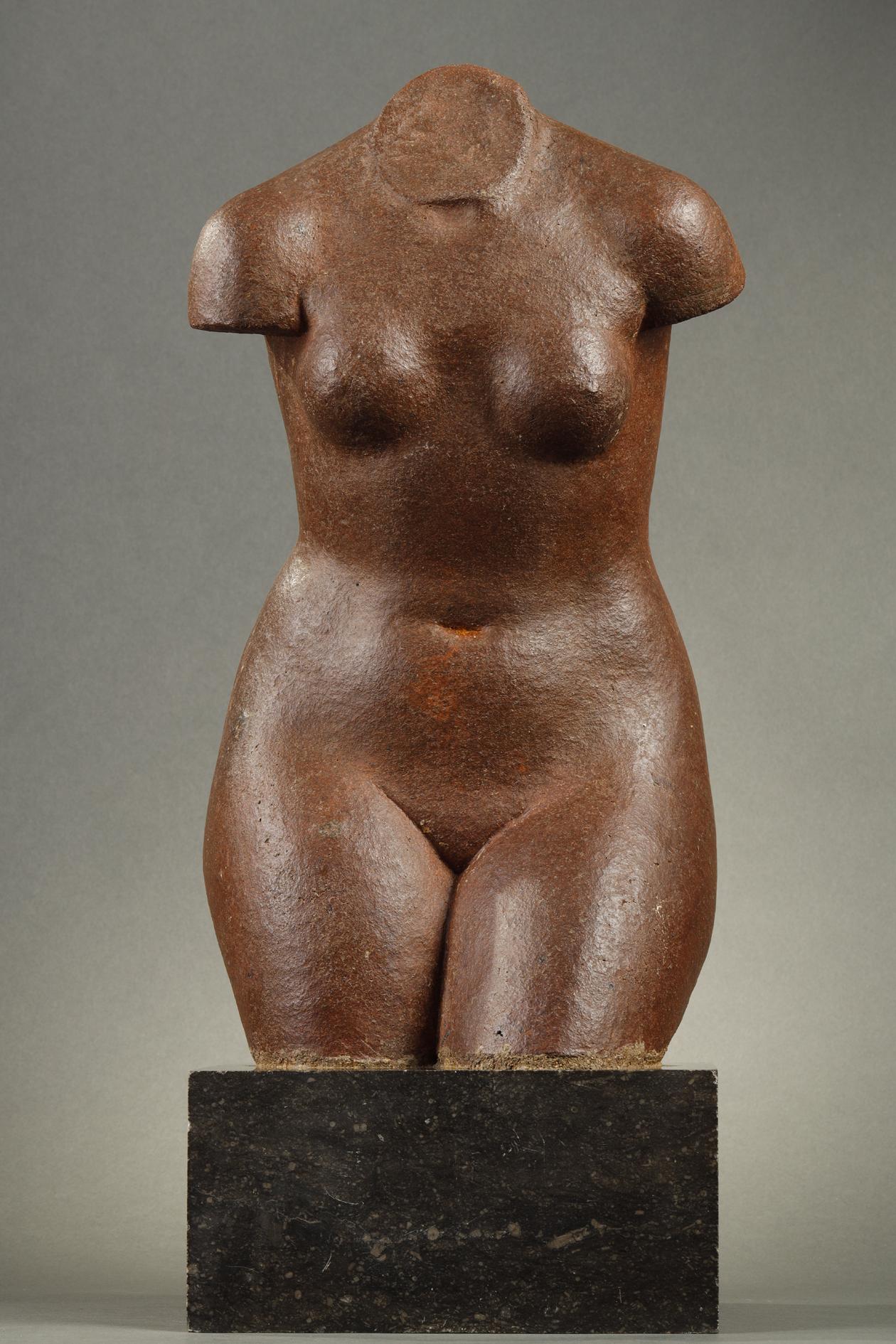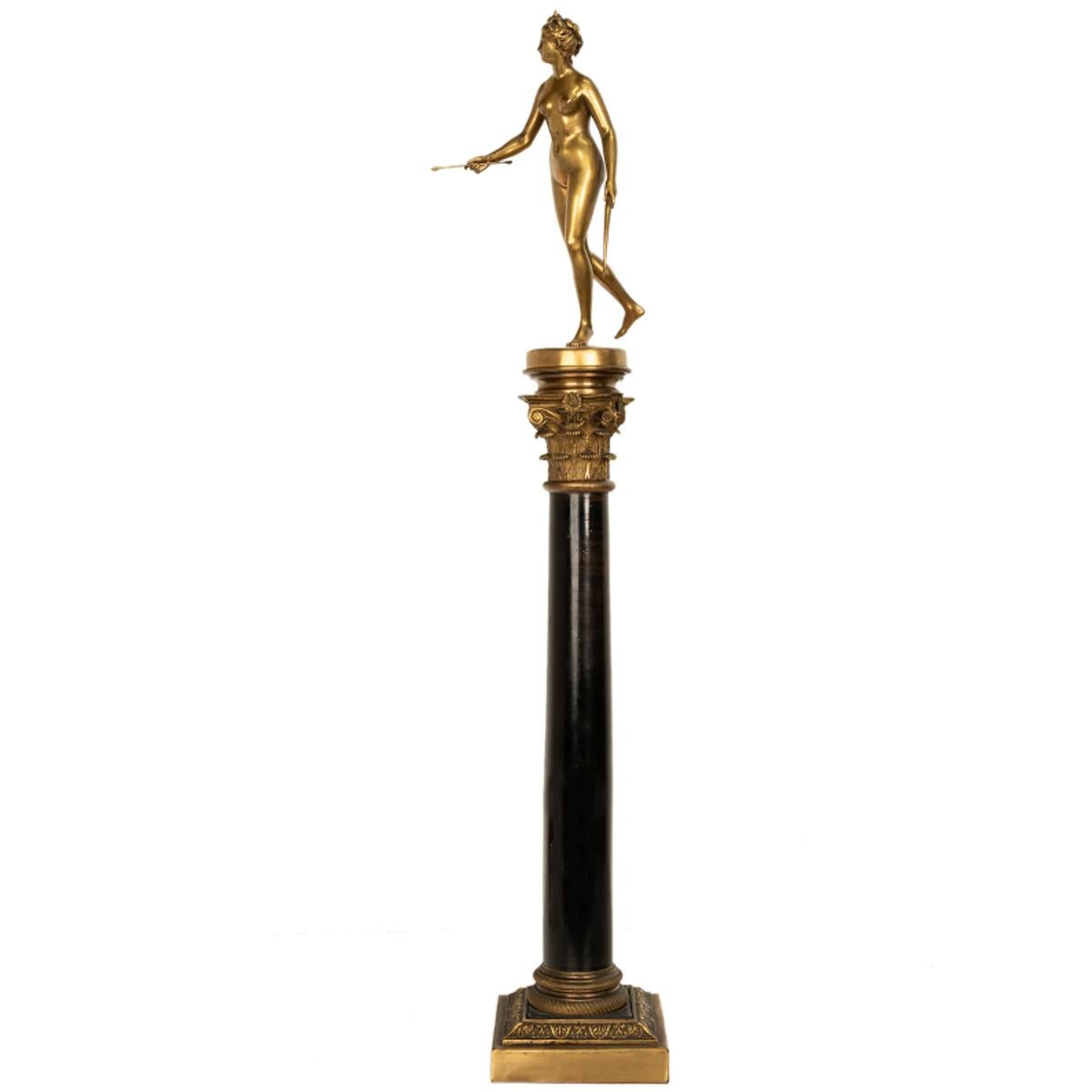Albert-Ernest Carrier-BelleuseYoung woman wearing a shawlcirca 1860
circa 1860
About the Item
- Creator:Albert-Ernest Carrier-Belleuse (1824 - 1887, French)
- Creation Year:circa 1860
- Dimensions:Height: 16.15 in (41 cm)Width: 9.45 in (24 cm)Depth: 6.7 in (17 cm)
- Medium:
- Movement & Style:
- Period:
- Condition:
- Gallery Location:PARIS, FR
- Reference Number:
Albert-Ernest Carrier-Belleuse
Albert-Ernest Carrier-Belleuse was a French sculptor. Carrier-Belleuse was born on 12th June 1824 at Anizy-le-Château, Aisne, France. He began his training as a goldsmith's apprentice. He was a student of David d'Angers and briefly studied at the École des Beaux-Arts. His career is distinguished by his versatility and his work outside France, in England between 1850–55 and in Brussels around 1871. His name is perhaps best known because Auguste Rodin worked as his assistant between 1864 and 1870. The two traveled to Brussels in 1871 and by some accounts, Rodin assisted Carrier-Belleuse's architectural sculpture for the Brussels Stock Exchange.

- ShippingRetrieving quote...Ships From: PARIS, France
- Return PolicyA return for this item may be initiated within 3 days of delivery.
- Suzanne SurpriseLocated in PARIS, FR"Suzanne Surprise" by Jean-Baptiste Carpeaux (1827-1875) Terra cotta "Propriété Carpeaux" Marked with the stamp ‘Propriété Carpeaux’ with the Imperial Eagle and the stamp 'Atelier ...Category
1870s French School Figurative Sculptures
MaterialsTerracotta
- Torso of a WomanLocated in PARIS, FRTorso of a Woman by Marcel GIMOND (1894-1961) Avery fine nuanced brown chamotte sandstone sculpture raised on a dark grey marble base signed on the arm with the monogram "MG" for Marcel Gimond inscribed with the monogram "GS" for Georges Serré stamped by the galerie Rouard France 1927 total height 50 cm width 20,5 cm depth 20 cm After a model by Marcel Gimond, this bust was made in 1927 by Georges Serré at the Manufacture de Sèvres, sold exclusively by the Rouard Gallery, and exhibited the same year at the Paris Fall Fair (Salon d'Automne). Reproduced in "Sculpteurs nouveaux, Marcel Gimond", Paul Fierens, Nrf, 1930, cover. Biographies : Marcel Gimond (1894-1961) was a French sculptor. He studied in Lyon, then at the School of Fine Arts in Lyon where he graduated in 1917. Finally he arrived in Paris the same year and settled in Marly-Le-Roi. Student of Aristide Maillol, he also met Raoul Dufy and Auguste Renoir. Gimond worked with Maillol until 1920, and left him to settle in Paris and regain his independence. He then moved into Renoir's former studio, made available by Jean Renoir. He exhibited at the Salon des Indépendants and the Salon d'Automne in 1922. In 1940, Gimond left Paris to settle in the South zone, in Lyon, then in Aix en Provence; He spent his summers at Saint-Félicien, at the house of poet Charles Forot. At the Liberation, in 1944, he returned to Paris and his workshop rue Ordener, he left only a few months before his death. From 1946 to 1960, he directed a workshop at the Ecole des Beaux-Arts in Paris. Marcel Gimond was known for his busts of political and artistic personalities. He also owed two bas-reliefs located in the lobby of the newspaper "L'Humanité", in tribute to Marcel Cachin and Gabriel Péri. Georges Serré (1889-1956) was a French ceramist. He worked at the Sèvres factory until 1914, when he was mobilized to go to war. He then went to Indochina where he taught ceramics at the art school of Bien-hoa for five years. On his return to France, he moved to Sèvres, rue Brongniart, but encountered difficulties in producing his works, until the intervention of the ceramist Emile Decoeur who obtained him help to build an oven for firing his ceramics. It was Georges Rouard and his gallery located on avenue de l'Opéra in Paris, who had noticed him at the International Exhibition of Modern Decorative and Industrial Arts of 1925, which presented him during his "exhibitions of contemporary French artisans". Georges Serré's taste for these sandstones came to him, among other things, from Khmer sculptures...Category
1920s French School Figurative Sculptures
MaterialsTerracotta
- ParrotletLocated in PARIS, FRParrotlet by Armand PETERSEN (1891-1969) & SEVRES Manufacture Sculpture in white paste porcelain Signed « A. Petersen » Old edition artwork. Stamped by the porcelain manufacture of ...Category
1930s French School Figurative Sculptures
MaterialsPorcelain
- Portrait of Albert DubarryLocated in PARIS, FRPortrait of Albert Dubarry by Léon-Ernest DRIVIER (1878-1951) Bronze with a nuanced greenish dark brown patina signed "Drivier" cast by "Montagutelli, Paris, cire perdue" (with the ...Category
1930s French School Figurative Sculptures
MaterialsBronze
- Bear BagpiperBy Christophe FratinLocated in PARIS, FRBear Bagpiper by Christophe FRATIN (1801-1864) Bronze with nuanced dark brown patina Signed on the base "Fratin" Old edition cast France mid-19th century height 10,5 cm Biography ...Category
Mid-19th Century French School Figurative Sculptures
MaterialsBronze
- BatherLocated in PARIS, FRBather by Etienne Hachenburger (19th-20th C.) Sculpture in white Carrara marble Signed on the side of the base "E. Hachenburger" A simiilar model was exhibited at the Paris Salon oh...Category
Early 1900s French School Nude Sculptures
MaterialsMarble
- L'AiglonBy Louis OuryLocated in Paris, FRLouis Oury (1867 - 1940) L’Aiglon, 1899 Terracotta with polychromatic patina Signed on the shoulder and Seal from Goldscheider on the reverse Dimensions : 65 x 40 x 30 cm (25 x 15 3/...Category
19th Century French School Figurative Sculptures
MaterialsTerracotta
- Antique French Grand Tour Gilt Bronze Statue on Column Diana the Huntress 1838By Ferdinand BarbedienneLocated in Portland, ORA fine & large (34" tall) antique French gilt-bronze on marble column of Diana, cast by Ferdinand Barbedienne (1810-1892) after a statue by Jean Antoine Houdon (1741-1828), the bronz...Category
1830s French School Figurative Sculptures
MaterialsMarble, Bronze
- RhinoBy Roland d'Andlau-HombourgLocated in Greenwich, CTBronze "Rhinoceros' by Roland d' Andlau-Hombourg (1927-2009) signed, numbered 1/6 with Godard foundry stamp R. d' Andlau was a gifted 'animalier' sculptor in the grand tradition ...Category
1950s French School Figurative Sculptures
MaterialsBronze
- Tusey Foundry, "Polyhymnia," Imposing Cast Iron Sculpture 19th centuryLocated in Pistoia, ITImpressive cast iron sculpture titled "Polymnie," Tusey Foundry, late 19th century. In modern times Tusey, a village in the Meuse, was best known for its renowned foundry. The found...Category
1890s French School Figurative Sculptures
MaterialsIron
- Napoleon IstLocated in Paris, FRAntoine-Denis CHAUDET (1763 - 1810) NAPOLEON Ist, circa 1808 Carrare Marble - First Empire Hermes Bust of Napoleon Ist, after Antoine-Denis CHAUDET Dimen...Category
Early 1800s French School Figurative Sculptures
MaterialsMarble
- Antique Bronze Dog Portrait of a Cavalier King Charles "Thigley" circa 1905Located in SANTA FE, NMAntique Bronze Dog Portrait of a Cavalier King Charles "Thigley" French School (possibly Franck Burty Haviland) Lost wax bronze casting Circa 1910 5 7/8 x 9 x 3 1/4 A sophisticated bronze casting of a Cavalier King Charles spaniel made in lost wax casting (cire perdue) from the beginning of the 20th century by Valsuani Foundry. This an unusual bronze approached in its aesthetic that’s reminiscent of the work of great animal sculptors of the second half of the 19th century except in this presentation which is more avant-garde for the time with a much looser, more impressionistic execution. The patina is a superb bronze color, brown and slightly greenish, going in places towards a more antique green. The attitude of the dog is extremely well and sensitively rendered with the placement of material unlike the renderings of a bronze by Barye...Category
Early 1900s French School Figurative Sculptures
MaterialsBronze



